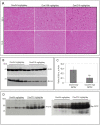HIV-1 Tat contributes to Alzheimer's disease-like pathology in PSAPP mice
- PMID: 19294002
- PMCID: PMC2655152
HIV-1 Tat contributes to Alzheimer's disease-like pathology in PSAPP mice
Abstract
Prevalence of HIV-associated cognitive impairment is rising. Amyloid-beta (A-beta) plaque deposition in the brain may be a contributing factor as epidemiological data suggests significant numbers of long-term HIV survivors are at elevated risk of developing Alzheimer's disease (AD). HIV-1 Tat-induced A-beta deposition, tau phosphorylation, and subsequent neuronal death could be risk factors for subsequent AD and/or HIV-related cognitive impairment. To mimic this clinical condition, we generated mice with HIV-1 Tat-induced AD-like pathology. We first performed a short-term Doxycycline (dox) dosing (54, 108, and 216 mg/kg/day) study in transgenic mice whose astrocytes express HIV-1 Tat via activation of a GFAP/dox-inducible promoter. After one week, mouse brains were examined histologically and the expression of Bcl-xL, Bax, and phospho-tau was investigated by Western blotting. We next cross-bred these mice with the PSAPP mouse model of AD. To simulate chronic Tat secretion over periods longer than one week, we used an optimized dose of 54 mg/kg/day on a biweekly basis over three months; based on the initial dose ranging study in the Tat transgenic mice. This was followed by antisera detection of A-beta, and Western blot for phospho-tau, Bcl-xL, and Bax. Tat significantly induced neuron degeneration and tau phosphorylation in Tat transgenic mice, dox dependently (P<0.001) with the most robust effects at the 216 mg/kg/day dose. In the long term study, similar effects at the chronic 54 mg/kg/day dose were observed in PSAPP/Tat mice induced with dox. These mice also showed significantly more A-beta deposition (P < 0.05), neurodegeneration, neuronal apoptotic signaling, and phospho-tau than PSAPP mice (P < 0.05). In conclusion, HIV-1 Tat significantly promotes AD-like pathology in PSAPP/Tat mice. This model may provide a framework in which to identify new mechanisms involved in cognitive impairment in the HIV infected population, and possible treatments. Additional works will be needed to fully characterize the mechanism(s) of HIV- induced amyloid deposition, and also to uncover viral mechanisms promoting AD-like pathology in general.
Keywords: Alzheimer's; Dementia; HIV-1; PSAPP; Tat; beta-amyloid.
Figures




Similar articles
-
Extracellular Vesicles: A Possible Link between HIV and Alzheimer's Disease-Like Pathology in HIV Subjects?Cells. 2019 Aug 24;8(9):968. doi: 10.3390/cells8090968. Cells. 2019. PMID: 31450610 Free PMC article. Review.
-
Impact of CRFR1 Ablation on Amyloid-β Production and Accumulation in a Mouse Model of Alzheimer's Disease.J Alzheimers Dis. 2015;45(4):1175-84. doi: 10.3233/JAD-142844. J Alzheimers Dis. 2015. PMID: 25697705 Free PMC article.
-
Impaired autophagy and APP processing in Alzheimer's disease: The potential role of Beclin 1 interactome.Prog Neurobiol. 2013 Jul-Aug;106-107:33-54. doi: 10.1016/j.pneurobio.2013.06.002. Epub 2013 Jul 1. Prog Neurobiol. 2013. PMID: 23827971 Review.
-
Caffeine Blocks HIV-1 Tat-Induced Amyloid Beta Production and Tau Phosphorylation.J Neuroimmune Pharmacol. 2017 Mar;12(1):163-170. doi: 10.1007/s11481-016-9707-4. Epub 2016 Sep 15. J Neuroimmune Pharmacol. 2017. PMID: 27629410 Free PMC article.
-
Effects of CX3CR1 and Fractalkine Chemokines in Amyloid Beta Clearance and p-Tau Accumulation in Alzheimer's Disease (AD) Rodent Models: Is Fractalkine a Systemic Biomarker for AD?Curr Alzheimer Res. 2016;13(4):403-12. doi: 10.2174/1567205013666151116125714. Curr Alzheimer Res. 2016. PMID: 26567742 Review.
Cited by
-
Enterovirus infection and its relationship with neurodegenerative diseases.Mem Inst Oswaldo Cruz. 2023 Mar 20;118:e220252. doi: 10.1590/0074-02760220252. eCollection 2023. Mem Inst Oswaldo Cruz. 2023. PMID: 36946853 Free PMC article.
-
Flipping the switches: CD40 and CD45 modulation of microglial activation states in HIV associated dementia (HAD).Mol Neurodegener. 2011 Jan 11;6(1):3. doi: 10.1186/1750-1326-6-3. Mol Neurodegener. 2011. PMID: 21223591 Free PMC article.
-
Role of Melatonin on Virus-Induced Neuropathogenesis-A Concomitant Therapeutic Strategy to Understand SARS-CoV-2 Infection.Antioxidants (Basel). 2021 Jan 2;10(1):47. doi: 10.3390/antiox10010047. Antioxidants (Basel). 2021. PMID: 33401749 Free PMC article. Review.
-
Readily Releasable Stores of Calcium in Neuronal Endolysosomes: Physiological and Pathophysiological Relevance.Adv Exp Med Biol. 2020;1131:681-697. doi: 10.1007/978-3-030-12457-1_27. Adv Exp Med Biol. 2020. PMID: 31646530 Free PMC article. Review.
-
Efavirenz promotes β-secretase expression and increased Aβ1-40,42 via oxidative stress and reduced microglial phagocytosis: implications for HIV associated neurocognitive disorders (HAND).PLoS One. 2014 Apr 23;9(4):e95500. doi: 10.1371/journal.pone.0095500. eCollection 2014. PLoS One. 2014. PMID: 24759994 Free PMC article.
References
-
- Valcour V, Paul R. HIV infection and dementia in older adults. Clin Infect Dis. 2006;42:1449–1454. - PubMed
-
- Levy-Dweck S. HIV/AIDS fifty and older: A hidden and growing population. J Gerontol Soc Work. 2005;46:37–50. - PubMed
-
- Stoff DM., Khalsa JH, Monjan A, Portegies P. Introduction: HIV/AIDS and aging. AIDS. 2004;18(Suppl 1):S1–2. - PubMed
-
- Green DA, Masliah E, Vinters HV, Beizai P, Moore DJ, Achim CL. Brain deposition of beta-amyloid is a common pathologic feature in HIV positive patients. AIDS. 2005;19:407–411. - PubMed
-
- Achim C, Masliah E, Vinters H, Schindelar J, Green D. Society of Neuroscience. Washington, DC: 2004. Beta-amyloid in the HIV brain.
Grants and funding
LinkOut - more resources
Full Text Sources
Other Literature Sources
Research Materials
Miscellaneous
